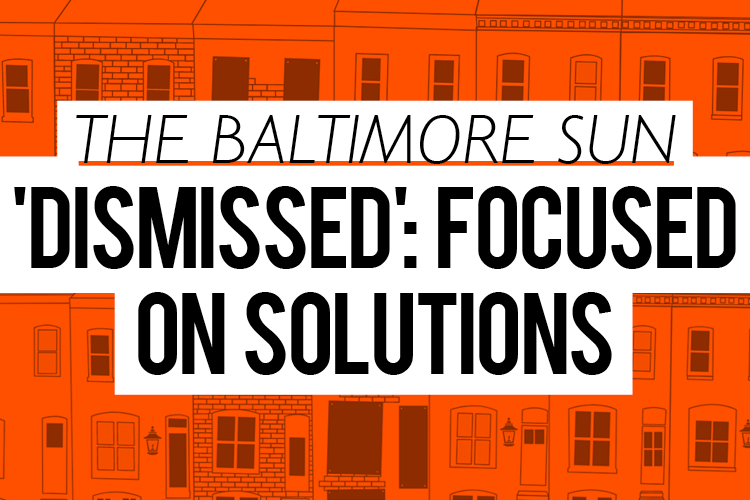
‘Dismissed’: Focused on solutions
Creator: The Baltimore Sun
Summary: Uses multiple tools — including an interactive 360 tour and a unique quiz — to help readers understand a controversial investigation.
_____________________________________________
Last year, The Baltimore Sun set out to untangle the city’s “widely misunderstood” housing court process — the first in the nation to establish a system for inspectors to hold landlords accountable for fixing substandard living conditions. Evictions had been a big problem in the city for years, and the newspaper hoped to go beyond the anecdotal assumption that low-income tenants’ delinquency was to blame.
The Sun hired an outside organization to scrape data on nearly a decade of cases in Baltimore City District Court and put that information into a searchable database. From there, the Sun’s reporting team could separate evidence from anecdote to discover whether the housing court was meeting the requirements of the law.
“It was a sweeping story that aimed to determine if an entire justice system (the busiest docket in the state) was fair to tenants. It isn’t,” says Doug Donovan, one of the lead reporters on the project. “But given the complexity of the topic — landlord-tenant law, housing inspection rules, implications of poverty, city programs to help low-income tenants, etc. — we knew we needed to take a multi-pronged storytelling approach: data visualizations, graphics, photographs and traditional storytelling.”
Working with Donovan were: writer Jean Marbella; Adam Marton, Jin Kim and Caroline Pate on data visualization; and editor Matthew Hay Brown.
The resulting package still put heavy emphasis on a typical investigative narrative as the anchor of the project, but that was broken up by multiple entry points, including a video, a podcast and photo galleries. Other explainer features embedded in the story brought readers directly into the cases that they were reading about to see firsthand evidence of the court process and rental conditions in a way that a traditional story alone could not.
A video quiz titled “You Be the Judge” presented the facts of three real-life Baltimore City Rent Court cases and allowed readers to select how they thought a judge might rule.
After selecting the answer, readers would see the actual results of the case and why the court ruled one way or another.
The news staff “needed to explain what could be boring, complicated government systems: the eviction process, the tenant-complaint (rent escrow) system and housing inspections,” says Donovan. “[The quiz] gave us another way to present our reporting and connect with users, particularly those who might not typically read an in-depth story.”
The story also incorporated a 360-degree view tool similar to what you might find on a real-estate website, which allowed readers to navigate inside a rowhouse and see evidence of 20 violations found by city inspectors.
Donovan sees the use of multiple tools, rather than just one device, as critical to explaining such a complicated story.
“There is a tremendous amount of social and legal undercurrents at play in the day-to-day crush of housing court cases. Overlay our investigative findings and there is a potential to plunk a text-heavy dissertation that would not capture or keep the attention of readers,” Donovan says.
Although “gamifying” the housing courts process had its pluses in terms of improving engagement on a complicated subject, the Sun got pushback over promotion of the tool.
“Avoid calling it a game. Avoid thinking of it as a game,” Donovan warns. “Otherwise you run the risk of offending readers if the presentation isn’t somber enough.”
Technical points and modifications: Newsrooms that lack the bandwidth to comb through troves of data or develop complicated online tools should get creative to build resources. “Find someone who can do it at a university or nonprofit who is motivated by a mission to enhance transparency of government and courts,” Donovan says. “Every university has a data analysis program of some sort. Such folks are out there.”
The Sun worked with Solutions Journalism Network, a nonprofit that helps develop reporting on complex social issues, often through nontraditional storytelling. Although the Sun team decided that a more traditional approach was right for the housing courts series, the collaboration with Solutions Journalism Network helped the newsroom experiment with and brainstorm future interactive projects.
Share with your network
- Improving accountability reporting: How to make the best of journalism better for audiences
- Recoding journalism: Some ideas to get started
- A portfolio of examples
- Tampa Bay Times: The LEGO Project
- NPR: The annotated speech
- Purple: The Political Messenger
- Los Angeles Times: Story stacks
- Baltimore Sun: ‘Dismissed’: Focused on solutions
- Washington Post: Tracking Trump
- Asheville Citizen-Times: Explaining redistricting
- ProPublica: A tweetstorm of facts
- New York Times: Visualizing America’s problems
- Axios: ‘Smarter Faster’ videos
- Wall Street Journal: Charting stock and tweets
- Your turn
You also might be interested in:
As research continues to inform this slice of the news industry, we’ll continue learning, too. Who gets to be called a journalist in 2025 and beyond? What is the future of trustworthy information, especially considering the access to and trust for online content creators? How might journalism adapt to the rise, or co-opt the styles, of news influencers?
What if we started looking at our output as a product, not a service? Too often, we think "product" means a fancy app or a new website. But product isn’t about tech. It’s about intention.
When we began asking what kind of stories still mattered to Baca County, we realized many of them weren’t “breaking news” but generational memory. And the paper was the last remaining platform that treated those memories with care and context.



